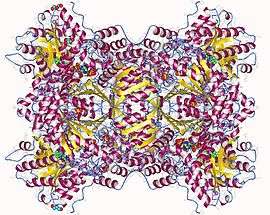Proline dehydrogenase
| proline dehydrogenase | |||||||||
|---|---|---|---|---|---|---|---|---|---|
|
Proline dehydrogenase tetramer, Bradyrhizobium diazoefficiens | |||||||||
| Identifiers | |||||||||
| EC number | 1.5.5.2 | ||||||||
| CAS number | 9050-70-8 | ||||||||
| Databases | |||||||||
| IntEnz | IntEnz view | ||||||||
| BRENDA | BRENDA entry | ||||||||
| ExPASy | NiceZyme view | ||||||||
| KEGG | KEGG entry | ||||||||
| MetaCyc | metabolic pathway | ||||||||
| PRIAM | profile | ||||||||
| PDB structures | RCSB PDB PDBe PDBsum | ||||||||
| Gene Ontology | AmiGO / EGO | ||||||||
| |||||||||
In enzymology, a proline dehydrogenase (EC 1.5.5.2, formerly EC 1.5.99.8) is an enzyme that catalyzes the chemical reaction
- L-proline + ubiquinone (S)-1-pyrroline-5-carboxylate + ubiquinol
Thus, the two substrates of this enzyme are L-proline and ubiquinone, whereas its two products are (S)-1-pyrroline-5-carboxylate and ubiquinol.
This enzyme belongs to the family of oxidoreductases, specifically those acting on the CH-NH group of donors with a quinone or similar compounds as acceptors. The systematic name of this enzyme class is L-proline:quinone oxidoreductase. Other names in common use include L-proline dehydrogenase, and L-proline:(acceptor) oxidoreductase. This enzyme participates in arginine and proline metabolism. It employs one cofactor, FAD.
Structural studies
As of late 2007, 9 structures have been solved for this class of enzymes, with PDB accession codes 1K87, 1TIW, 1TJ0, 1TJ1, 1TJ2, 1Y56, 2FZM, 2FZN, and 2G37.
References
- Scarpulla RC, Soffer RL (1978). "Membrane-bound proline dehydrogenase from Escherichia coli Solubilization, purification, and characterization". J. Biol. Chem. 253 (17): 5997–6001. PMID 355248.
